In The Archives: Story Makes Full Circuit
Editor’s note: In her most recent local history column written for The Chronicle, “When Work Was Walkable,” Laura Bien described a series of relationships that existed 100 years ago between people who lived within walking distance of their work. She included the following lines: “When Daniel [Quirk] visited the mill, he may have been driven by his coachman, Manchester Roper. By 1910, Manchester had been hired as one of the two servants in Daniel’s household.”
A Chronicle reader recognized that his grandmother had been the other servant. That reader contacted Bien. And Bien got permission to explore the family archives. This month’s column grew out of that research. Fair warning: There’s a bit of ground to cover first before you’ll learn the identity of that reader. But as always with Bien’s text, it’ll be worth the wait. Keep your eye on Mabel.
As 1900 began, 77-year-old York Township farmer Horace Parsons knew that his wife Maria was gravely ill.
His first wife Margaret had died half a century earlier, three years after their New Year’s Day wedding. Horace married his second wife Mary Ann on New Year’s Day, 1850. Just months later, his mother Rebecca died. The following year, Mary Ann died, possibly in childbirth, and Horace’s father Orrin died.
Horace had seen them all laid to rest in Saline’s Oakwood Cemetery.
Horace married his third wife Maria on May 14, 1860. Over their four decades together, Horace and Maria shared the hardships of 19th-century Michigan farm life. They lost one of their children. They survived lean years early in their marriage, selling off sheep, pigs, and farm machinery. Unlike some neighbors, they hung on to their mortgage, expanding the farm from 30 acres to 50 in 1870 and 66 a decade later.
That year Horace’s restored flock of sheep was up to nearly 80 head and 30 lambs, plus cows and pigs. He grew oats, beans, wheat, potatoes, and Indian corn, and tended 2 acres of apple trees. His and Maria’s place was the typical mixed-crop, mixed-livestock Washtenaw County farm of the era. The heterogeneity of their farm and those of their neighbors was insurance against the not uncommon disasters that regularly struck down one or another animal or crop.
Now his and Maria’s time together, he could see, was ending.
Horace hired a local girl to help. Mabel was a teenager, though neither the term nor the concept existed when she came on as a servant on Horace’s farm. Mabel was the oldest child of brickyard worker and general laborer Orson Pepper and his wife, homemaker Myrtie. The young mother had been a schoolgirl only shortly before Mabel’s birth in 1884.
Mabel lived in the Parsons’ farmhouse with Horace, Maria, and the couple’s two unmarried adult children, Charles and Minnie. In July of 1900, Maria died of what was determined to be heart disease. Just three years later, Horace died at age 80 of what was thought to be Bright’s disease, a kidney ailment.
By 1905, Mabel had five younger brothers: Bina, Glen, Carl, Thayer and Orville. The family moved to Ypsilanti, settling in a small frame house at 212 Normal St.
Orson and Glen got jobs as laborers, Bina was hired as a railroad worker, and Carl clerked in G. B. Dunlap’s Michigan Avenue grocery. In the fall of 1909, Carl married Alice Webster, a onetime house servant of Ypsilanti bank cashier and Peninsular paper mill secretary Daniel L. Quirk.
It may have been due to Alice and Carl’s connection that Mabel was hired by Quirk. By 1910, she worked as a domestic in the large Quirk mansion on North Huron.
Mabel was experienced and a good worker. Known for her cooking, she likely cooked for the Quirks. One dessert specialty of Mabel’s still fondly remembered by a living granddaughter is “Blueberry Grunt,” a hot blueberry cobbler studded with dumplings and served with cream.
As with her hiring in the Quirk home, the next turn in Mabel’s life may also have come from family connections. Her brother Bina worked as a railroad teamster. Another railroad employee was called “Lon” – short for Alonzo. In the fall of 1915, Mabel married Lon in Potterville in Eaton County. The couple moved to Albion, where Lon worked as a railroad foreman.
Mabel and Lon’s respect for family tradition showed in their children’s names. Mabel’s first child, born in 1916, was named John Orson, a combination of the names of Mabel’s and Lon’s fathers. Mabel’s daughters’ names – Myrtie and Olive – honored Mabel’s and Lon’s mothers. Mabel’s son’s name – Hugh Alonzo – commemorated the infant’s paternal great-grandfather and father. Mabel’s fifth and last child, Frieda, was born in 1924.
The family moved to Parma in Jackson County. Money was tight. While many of their neighbors owned the new technology, a radio set, they did not.
In time came a move to a farm in nearby Springport that had belonged to Lon’s grandfather and father. The former teen servant now had a family and a home of her own. She also had a car, though according to one living descendant, “I never saw my grandmother drive and do not think she ever learned. Their old car had been around so long and she was so short and heavy that the seat springs on the passenger side were so crushed that she almost literally sat on the floor and could not see [through] the window.”
That’s the recollection via email of Mabel’s grandson, who as a boy visited the Springport farm with his father Hugh. Now a Saline area resident, Don still recalls those occasions.
“My vivid memories of overnight stays as a young boy there included sleeping on itchy flannel sheets in a very cold upstairs bedroom,” Don recalled, “and trying very hard to not have to go outside to the two-holer outhouse (complete with Sears catalog) until the light of dawn arrived.”
The onetime servant girl had become a beloved grandmother. “[She] was very short and very round,” wrote Don. “She was known as a good cook and did everything from scratch, including making her own butter, which always had a salty taste to preserve it longer.”
After family dinners, the playing cards came out. “The nightly ritual often included playing Canasta,” wrote Don. “My grandmother would fall asleep between her plays and my grandfather would yell ‘Mabel, wake up god dammit!’ to which she would inevitably reply ‘I was just resting my eyes’ as she scanned the table to try to figure out what cards had been played.”
Don described his grandfather Lon as a survivor “who had scratched out a living anyway he could. My father [Hugh] told me that Lon … would make money by taking his team of horses out after a big snow storm and offer to pull stranded cars from the ditches for a dollar, which was a lot of money then.” Sometimes they say that family traits skip a generation. It may be that Mabel and Lon’s lives of hard work made an impression on their grandson.
Don continued, “[Lon] taught me to play cribbage (I think I was about 11 or 12) by showing me how to count the points for one hand. After that, his ‘rule’ was that he got to take all the points I missed for himself.”
Don concluded, “It made me a quick learner.”
That quick learner excelled in school. He earned a master’s, a doctorate, and a UM law degree. He worked as an Army lawyer and later for local law firms.
Don went on to serve as city councilman and then mayor of Saline. He taught at Thomas Cooley Law School, Oakland University, the University of Maryland, and Eastern Michigan University, where he still teaches (he founded an EMU scholarship fund and served as an EMU regent for good measure). He published, among numerous professional articles and chapters in legal publications, a book on the use of forensic science in the courtroom.
He’s even been on NPR twice to discuss the “CSI Effect”. This theory posits that TV courtroom dramas’ emphasis on seemingly infallible forensic technology has influenced real-life jurors to more readily acquit if the same high-tech evidence doesn’t appear in a real court. (Don’s verdict: Nope.)
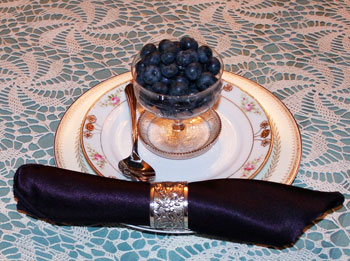
The silver napkin ring, a link to the family's past.The family posed it here with blueberries "to honor Mabel." (Image links to higher resolution file.)
The gentleman who remembers itchy sheets and farmhouse meals of long ago is today the chief circuit judge for Washtenaw County’s trial court, the Honorable Donald Shelton.
Just as Mabel honored her ancestors, Judge Shelton and his wife Marjorie remember theirs. One prized family possession is a silver napkin ring passed down from Mabel’s daughter Myrtie. In addition, Judge Shelton notes, the extended family still observes “an annual reunion, called the Culver Cousins Reunion after our progenitor Phineas Culver who migrated from upstate New York to Mooreville, Michigan [in York Township] through the [then-] newly available Erie Canal.”
“This year we will hold our 99th reunion.”
One only wishes Mabel could also attend, to share some Blueberry Grunt with her grandson and his family. She’d beam with pride.
Grateful thanks to the Sheltons for their invaluable help, without which this article would not have been possible, and for the use of their personal photographs.
Mystery Artifact
Last column, Dave and Murph correctly guessed that the article in question was a seamstress’ sewing clamp, formed into a decorative bird shape.
You can view the object on the second floor of the Ypsilanti Historical Museum in the front sewing room.
This week we’re remaining on the second floor to take a peek at this odd object.
A bit over a yard tall, it’s something that just might have been used by one person mentioned in the article above.
What might it be? Good luck!




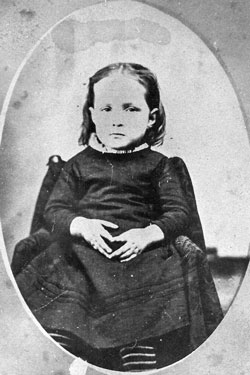
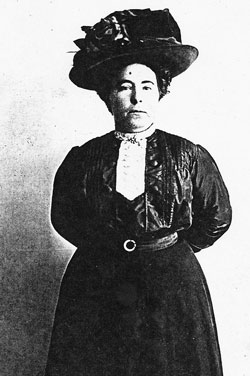
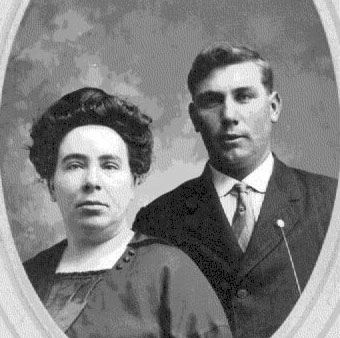
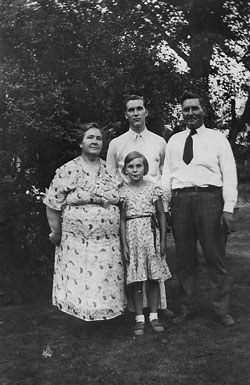
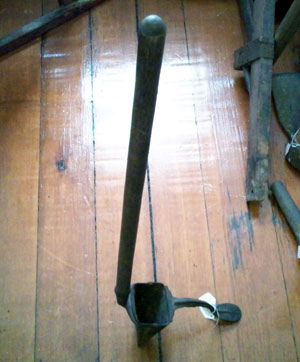
That’s a great story, and nice to have it all unwrap to present us with a well known contemporary local.
Just a hunch, after a long spell in the garden today, that that is a seed planter. Seeds go in hopper, foot holds little pedal, arm pushes handle forward to force funnel cone in dirt. Not visible little flap is pushed up by dirt allowing seed(s) to fall out of hopper and into soil when device is removed.
Or it could be a musical instrument; toot, toot!
Thank you for your kind comment Cosmonican. It couldn’t have been written without the invaluable help of the Sheltons, who took time out of their days to humor my questions. Thanks really go to them for sharing their family history.
…Oh, forgot to say: hmm, wouldn’t a lot of seeds fall out with each push into the dirt? That would add up quick for the average subsidence-level 19th-century Washtenaw Cty. farmer I daresay. Perhaps something other than seeds goes in the little hopper. :)
It could be a snuffer, but the shape is wrong and I can’t find any photos of old snuffers that look anything like this. It looks to me like the foot is fixed, and is only there so the thing will stand up.
As usual, Laura, interesting story with delightful details.
I think the object is some kind of funnel, perhaps useful in making moonshine.
Jim: Interesting guess. Hmm, turns out that little foot is actually part of a moving component.
Joan: Thank you very much for reading! Moonshine funnel! :) But then there’s that odd handle…hmm…
So then it’s an all-in-one whiskey making tool. First you use it to plant the corn, then to funnel the whiskey into the bottles, and finally you snuff out the fire under the still with it.
Interesting guess Jim…but I have to confess that this doodad is closer to vodka than to whiskey…
It’s for planting potatoes? Or harvesting them?
Laura,
My daughter and I agree with Jim. It looks like a potato planter to us.
Irene Hieber
That seems to be it. Here’s one in the open position: [link]
Well, given that evidence I have to break with tradition and say that Jim and Irene are correct. It’s a manual tater planter. Great deduction!